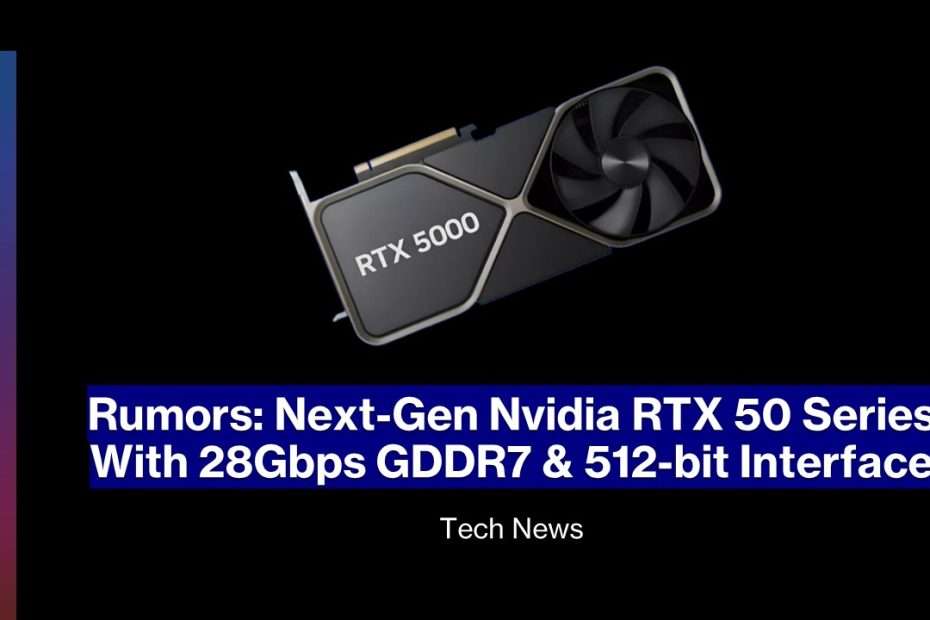The release of Nvidia’s RTX 50-series GPUs is a topic of much speculation, with rumors swirling about potential launch windows in late 2024 or early 2025. Despite this distant timeframe, the rumor mill is in full swing, generating reports on everything from their specifications to architecture, performance expectations, and power requirements. Enthusiasts and tech analysts alike are eagerly anticipating what these GPUs might bring to the table, with hopes high for significant advancements in graphical capabilities and efficiency.
As Nvidia continues to develop its next-generation GPUs, details are emerging about the potential specifications of the RTX 50-series. One of the most intriguing rumors suggests that these GPUs will utilize 28Gbps GDDR7 memory paired with a 512-bit interface. While the exact release date remains uncertain, the prospect of these new GPUs has the tech community buzzing with anticipation for the innovations they may bring.
NVIDIA GeForce RTX 50 series reportedly features 28 Gbps GDDR7 memory https://t.co/9IBYvsQVI0
— VideoCardz.com (@VideoCardz) March 11, 2024
Prolific tipster @kopite7kimi recently revealed new details about the upcoming RTX 50 “Blackwell” graphics cards. These GPUs are said to be based on the GB202 and GB203 architectures, with the former speculated to be the flagship model boasting the full complement of cores. On the other hand, the GB203 variant is expected to be a cut-down version, featuring half the number of cores compared to its flagship counterpart. This differentiation suggests that Nvidia is aiming to offer options catering to both high-end performance enthusiasts and those looking for a more budget-friendly option within the RTX 50 series lineup.
I think GB203 is half of GB202, just like GB102 and GB100. But I don't know if GB202 has a multi chip package.
— kopite7kimi (@kopite7kimi) March 11, 2024
The upcoming RTX 50 “Blackwell” GPUs, based on the GB202 and GB203 architectures, are poised to bring significant advancements over their predecessors. For perspective, the current-gen AD102 GPU in the RTX 4090 series boasts an impressive 80 percent increase in cores compared to the AD103, which powers the RTX 4080 and lower models.
While @kopite7kimi’s recent post provided insights into the core counts of the GB202 and GB203 GPUs, there remains uncertainty about a crucial detail. The tipster expressed uncertainty regarding whether the GB202 variant will utilize a multi-chip package. This aspect could significantly impact the design and performance characteristics of the GPU, leading to speculation about potential configurations and power efficiency. As the rumors and leaks continue to surface, tech enthusiasts eagerly await official announcements from Nvidia to shed more light on the intricacies of the upcoming RTX 50 “Blackwell” series.
The latest rumors suggest that the upcoming Blackwell gaming cards may introduce a notable upgrade in memory specifications. These GPUs are expected to feature a 512-bit memory interface, which would mark an increase from the 384-bit interface found on the flagship AD102 Ada GPU. This contrasts with a previous rumor indicating that the GB200 gaming GPUs would retain the same 384-bit memory interface as Ada, potentially limiting their maximum memory bus to 384 bits.
Additionally, reports indicate that the initial set of Blackwell gaming cards is likely to ship with 28Gbps GDDR7 memory. Although this falls slightly below the 32Gbps maximum capacity of GDDR7 chips, it still represents a substantial increase from previous generations. For context, GDDR6 memory offered bandwidths up to 18Gbps, while GDDR6X pushed that to 21Gbps. Nvidia is expected to maintain 16Gbit densities for the GDDR7 memory chips, but details regarding the memory bus widths of the individual SKUs have not yet been revealed.
It’s important to approach these rumors with a level of skepticism, as details about upcoming products can often change before their official release. The information circulating about the RTX 50 “Blackwell” series should be taken with a pinch of salt, as there may be adjustments and refinements made to the specifications before the cards hit the market.
Like with any pre-release information, the details surrounding the RTX 50 “Blackwell” series should be viewed as speculative until Nvidia provides official confirmation. The tech community eagerly anticipates further updates and announcements from Nvidia as the launch window for the RTX 50-series cards approaches. Only then will we have a clearer picture of the actual specifications, capabilities, and performance of these highly anticipated graphics cards.
Maybe you liked other interesting articles?

